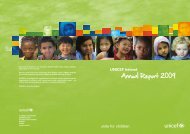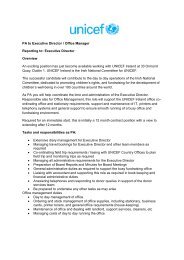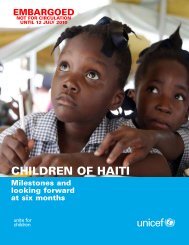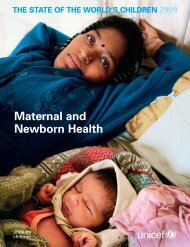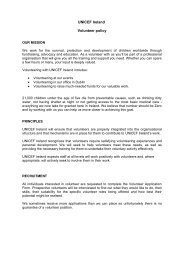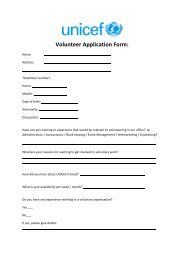Humanitarian Action for Children 2011 - Unicef
Humanitarian Action for Children 2011 - Unicef
Humanitarian Action for Children 2011 - Unicef
- No tags were found...
Create successful ePaper yourself
Turn your PDF publications into a flip-book with our unique Google optimized e-Paper software.
2009, 259 internal and standby surge staff weredeployed across the entire organization. Forcountries facing both large- and medium-scaleemergencies in 2010, UNICEF mobilized a significantemergency staff surge to strengthen thecapacity of country offices. This surge took the<strong>for</strong>m of technical support, management and clustercoordination, and such operational supportas human resources, supply and logistics, andin<strong>for</strong>mation management. Emergency capacityfrom within the organization was complementedby expertise drawn from standby partners fromgovernment and private companies, as wellas from 18 NGOs. These partnerships allowedUNICEF to deploy 185 personnel to 35 differentoffices, representing more than 23,000 days ofdeployment and an increase in standby deploymentsof more than 34 per cent.In 2010, global emergency supply needs morethan doubled as compared to 2008 and 2009combined. Through accelerated use of all itsassets, the UNICEF Supply Division in Copenhagenmet its commitment to pack and shipemergency supplies within 48 hours. Logisticsnetworks in the field and at headquarters contributedto better in<strong>for</strong>mation sharing betweenpartners and better identification of what productswere needed and where, as well as torenewed supply training and the release of crucialstaff <strong>for</strong> temporary deployment. Competingdemands <strong>for</strong> large quantities of similar suppliesduring simultaneous large- and medium-scaleemergencies proved challenging, however, andways to improve supply flow in such circumstanceswill be addressed during <strong>2011</strong>.In the immediate aftermath of the Haiti earthquake,which also damaged UNICEF’s premises,emergency in<strong>for</strong>mation technology and telecommunicationsresponse kits were shipped to Portau-Princefrom in-house stock piles and set up byemergency-trained experts from within UNICEFand standby partner organizations. While thesekits enabled essential telecommunications links<strong>for</strong> the makeshift office, other key in<strong>for</strong>mationtechnology services could not immediately beestablished on site. The office had to rely insteadon a shadow office operating out of the DominicanRepublic to host key UNICEF in<strong>for</strong>mationsystems which were accessed remotely fromPort-au-Prince.In 2010 UNICEF made considerable investmentsin developing a programming approach that ismore in tune with and in<strong>for</strong>med by emergencyrelatedrisks. A key goal of this trans<strong>for</strong>mation is<strong>for</strong> all UNICEF country programmes to increasetheir attention to disaster and conflict prevention,mitigation and preparedness. The newapproach provides a strong plat<strong>for</strong>m <strong>for</strong> engaginggovernments and other partners in sustainablestrategies <strong>for</strong> reducing humanitarianrisks, with long-term benefits to communitiespotentially affected by emergencies. Mainstreamingrisk-in<strong>for</strong>med programming and providingguidance to country offices on disasterrisk reduction are essential to strengtheningpractice in this area.Investing in national capacity developmentbe<strong>for</strong>e, during and after crises can help nationalactors fulfil their obligations to uphold and promotechildren’s and women’s rights in humanitariansituations. While not new to UNICEF,capacity development has not been systematicallyapplied in emergency settings and hasoften not been comprehensive enough to ensurereal and lasting change. UNICEF is now developingtechnical guidance on capacity developmentin humanitarian settings and has provided directsupport to Southern Sudan and to the Ugandacountry office in applying this approach, includingin post-conflict and fragile settings.Headquarters further provided guidance toUNICEF staff on the purpose, principles and keymanagement entry points <strong>for</strong> applying an earlyrecovery approach in humanitarian action. Staffsurge support on early recovery focused particularlyon Haiti and Pakistan to strengthen planningand response. UNICEF remained very engaged inpolicy development and country-level initiativesto ensure enhanced United Nations coherence inthe context of complex emergencies. A technicalnote on engaging integrated United Nationspresences was developed to complement interagencyguidance and a peer reference group wasestablished <strong>for</strong> UNICEF staff working in countrieswith these missions. UNICEF staff participatedin a number of inter-agency integrated strategyplanning and assessment missions, including toBurundi, Côte d’Ivoire, the Democratic Republicof the Congo, Somalia and Timor-Leste.Global support: Looking <strong>for</strong>wardCore Commitments <strong>for</strong> <strong>Children</strong> in<strong>Humanitarian</strong> <strong>Action</strong> and per<strong>for</strong>mancemonitoringUNICEF is continuing the rollout of the revisedCCCs and is encouraging all country and regionaloffices to adopt a standard- and coverage-basedapproach to monitoring and reporting duringemergency responses. The approach includesper<strong>for</strong>mance indicators aligned to the CCCs andglobal standards, which will also be consistentwith Inter-Agency Standing Committee (IASC)initiatives. This monitoring and reporting initiativeis benefiting from experience acquired inHaiti and Pakistan and is now being piloted inSouthern Sudan.<strong>Humanitarian</strong> re<strong>for</strong>mCapacity building to strengthen UNICEF’s role asthe global cluster lead in water, sanitation andhygiene (WASH); nutrition; education (along withSave the <strong>Children</strong>); and the child protection andgender-based violence areas of responsibility(the latter along with the United Nations PopulationFund) will build on lessons learned in Haitiand Pakistan and during other emergencies.www.unicef.org/hac<strong>2011</strong> | <strong>2011</strong> UNICEF <strong>Humanitarian</strong> <strong>Action</strong> FOR CHILDREN 15




